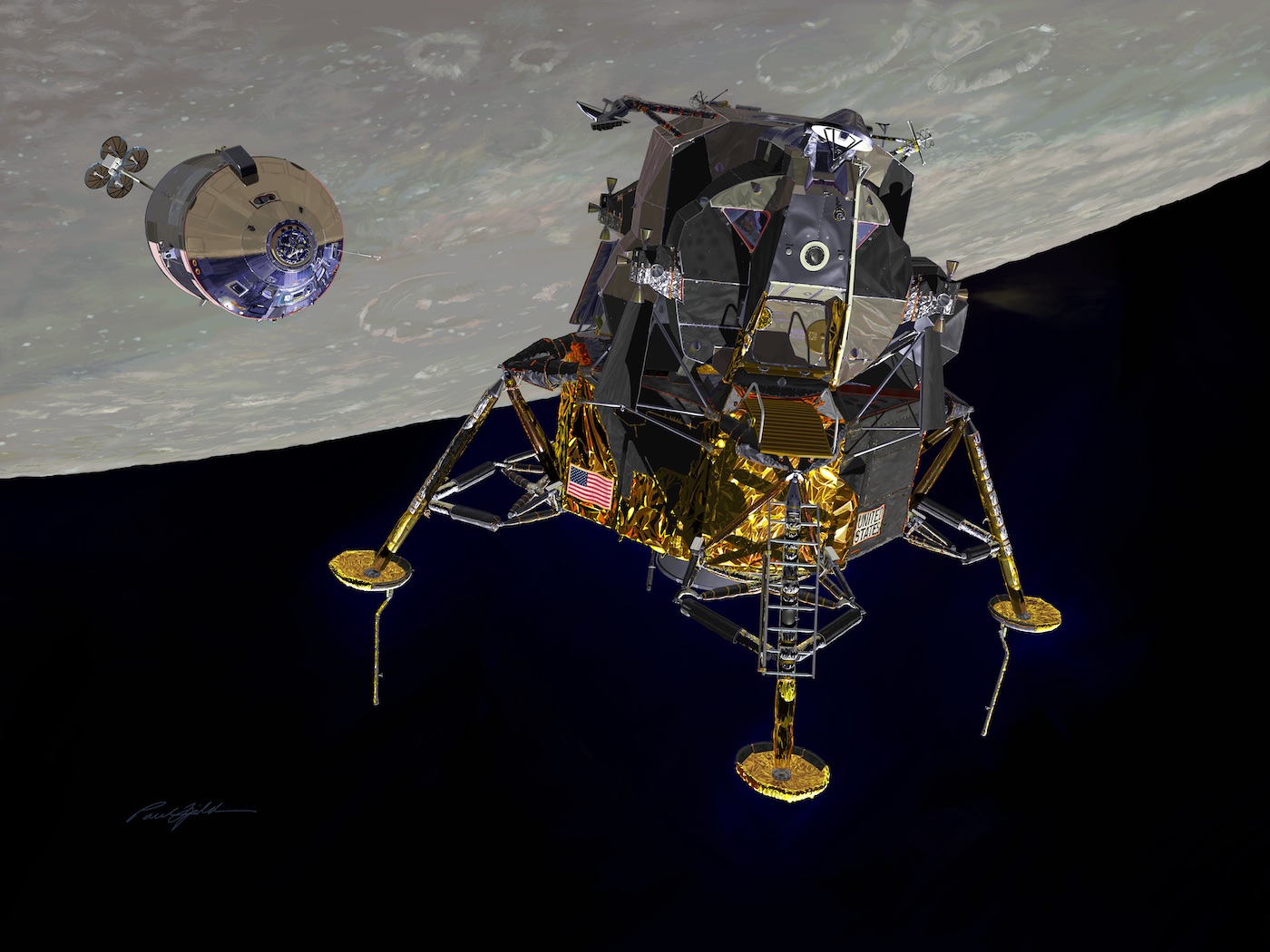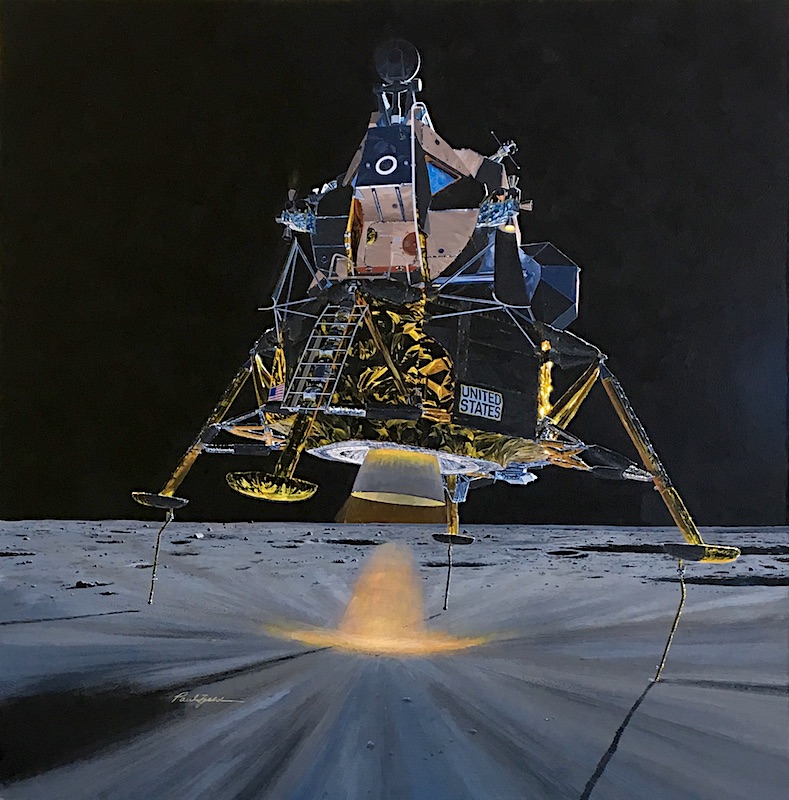
The Eagle Flies
On the afternoon of July 20, 1969 in bright lunar noon, flying 63 miles above what would years later be named King crater, Apollo 11's Lunar Module Eagle was hanging on to Columbia by three little capture latches at the end of its docking probe. "You guys all set?" radioed Command Module pilot Mike Collins to his crewmates, the commander Neil Armstrong and the LM pilot Buzz Aldrin in Eagle. At 17:44 UT he hit a switch that retracted the latches then pulled on his T-handled controller, firing two jets against the LM to start a gentle separation maneuver. "Okay, there you go — see ya," said Collins.
Armstrong yawed Eagle right then pitched up until he was facing his mothership, now some 70 feet in front of him. After waiting for Collins to stop moving, he twisted his attitude controller right a few times to begin a complete pirouette, angled to show the LM's legs so Collins could check that they were down and locked. A minute later they flew into earthrise and a chipper greeting from Houston. "How does it look, Neil?" asked capcom Charlie Duke.
"The Eagle has Wings," said Armstrong. His ship, for the first time after its long life in the factory and at the launch site, was ready for its main function. Its potential — propellant tanks full, batteries at charge, astronauts charged up — would be realized over the next two hours and 23 minutes. Collins was impressed. "I think you've got a fine looking flying machine there, Eagle, despite the fact you're upside down." "Somebody's upside-down," said Armstrong.
One orbit later, in darkness opposite the landing burn start point, they briefly fired the Descent Engine, cutting their 5365 feet per second velocity by 80 fps and dropping their orbit, half a moon later, to a low altitude of about 10 miles.
Their braking burn began a planned twelve minute sequence to touchdown, mostly at full throttle. After six and a half minutes, Eagle had dumped nearly three quarters of their propellant and killed a similar fraction of their velocity. Throughout this sequence in the descent, the crew were distracted by several computer overload alarms, caused by the unused Rendezvous Radar leaking a constant stream of useless pointing interupts, but the computer hung on, dropping only a couple of navigation updates. Eagle throttled down to 57% and then at 7,200 feet high switched guidance targets, tilting the LM forward so Armstrong could get a look at where he was going. Instead, Armstrong checked his control inputs — Eagle responded well — and then checked where he was going. Sighting 33 degrees down along a grid painted on his window, he saw that the LM was being guided to a "pretty rocky area."
The rocks were actually boulders, big as cars, on the side of a 1000 foot crater named West — not a place to land. So now, at 500 feet altitude, it was time for Armstrong to be a real pilot. He flipped a switch to Attitude Hold, grabbed the attitude controller in his right hand, grasped a little Rate of Descent switch between his left index finger and thumb, and began to slow his descent and extend his flight. He saw a nice spot half a mile downrange just short of a small 130 foot crater and started for that, but changed his mind and, slowly, slowly, crept past the crater only some 100 feet above it. All this took gas, much more than had been used in training. "I got a good spot," he finally told Aldrin who was calling a constant, clear stream of useful information to his commander.

The spot was relatively flat with several small craters nearby that wouldn't cause trouble if Armstrong drifted into them. But, as he got closer, there was a surprise. "Kicking up some dust," announced Aldrin in between callouts of descent rate, height, and now fuel remaining. To himself he was urging Armstrong to "get it down, get it down." A sharp call from Houston made their situation clear: "60 seconds!" That was a countdown to a bingo fuel call: land in 20 more seconds or abort right away. Then, "30 seconds!" to the abort decision point. Armstrong was having a bit of trouble.
He was confused about his motion as dust streamed away from the descent engine's thrust deflecting off the moon. It gave him a false sense of moving backwards and hid the rocks from which he could gauge his height. He ruefully recalled that his control just before touchdown was jerky, overcorrecting for a right drift and sliding left. The LM had also drifted in yaw, putting the shadow of Eagle to the right of his window behind the big front beam of the LM's face, depriving him of a useful guide to touchdown. So that was maybe not the best Lunar Module flying technique, but he had never flown a LM before. No one had. That is the story here as Eagle contacted the surface at 20:17:40 Universal Time that Sunday in 1969 and clumped to a stop, becoming a base at Tranquility.
The landing was an act of experience coupled with imagination. Armstrong had integrated his training habits, of muscle memory in the LM simulator cockpit, of flying a crazy training contraption that simulated landing in lunar gravity, maneuving by the hammer blows of gas jets. Neil Armstrong pulled all that together, anticipating the action of flying Eagle 240,000 miles from Earth to the moon's surface so that when he did it for real — for the first time with the whole world watching, as the small sharp point of the efforts of 400,000 people, of a country — he would not fail.
The following five commanders, flying their Lunar Modules for the first time as well but knowing that it could be done, added five more lunar bases to this incredible feat of Apollo. It laid down a tremendous marker, a gesture to humanity, a promise that we could be anywhere in the Cosmos, live anywhere in the Heavens.

